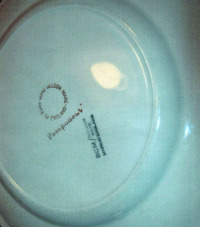Q: I have sent you a photo of a dish with a matching silver metal tray. I'm hoping you can explain the mark on the back and also tell me its value. I am in the midst of sorting out things that I have held onto for a long time. The dish is decorated with yellow, blue and red flowers against a yellow background, and it is sitting in a silver metal tray. The words marked on the back of the dish are blurry and appear to say, "Golden Maire — Made for Farberware — by the Sebring Pottery Co. —-Sebring, Ohio — Reg. U.S. Pat. Off. No. 230447." It measures 11 inches in diameter and is in perfect condition. I am 72 and have always remembered it from my mother's home.
A: The mark should say "Golden Maize" rather than "Golden Maire." Sebring Pottery Co. made semi-vitreous pottery in Sebring and East Liverpool, Ohio, from 1887 to 1948. The Farber Brothers were located in New York City and known for their Farberware. Sebring made dishes in several floral designs and sizes for Farberware metal holders. The "U. S. Patent No. 230447" shows that the design was registered with the government around 1940.
Your dish with metal tray would probably be worth $25 to $50.
Q: This is the manufacturer's mark on the back of a plate that I have. I bought it at a flea market at least 30 years ago, just because I loved the pattern. I am now cleaning out our attic and cannot part with it until I learn some of its history and value. The plate is approximately 8 inches by 8 inches and has scalloped edges. On the right side is a woman in an 18th century style purple gown sitting near a table with a teapot on it and there is a tree with an English style cottage in the background. The plate is decorated with gold flowers against a white background.
Thank you for any information that you might provide.
A: You have an example of chintz ware pottery. "Lord Nelson Ware" was made by Elijah Cotton in Staffordshire, England, from 1920 to 1940. "Pompadour" is the name of a chintz ware-style pattern and was inspired by Madame Pompadour, a favorite of the French King Louis XV. Chintz was a type of cotton that was imported to France from India in the late 18th century. Madame Pompadour used the fabrics for clothing and decorating.
Your circa 1920 dish would probably sell in the range of $25 to $50.
Address your questions to Anne McCollam, P. O. Box 247, Notre Dame, IN 46556. Items of a general interest will be answered in this column. Due to the volume of inquiries, she cannot answer individual letters. To find out more about Anne McCollam and read features by other Creators Syndicate writers and cartoonists, visit the Creators Syndicate website at www.creators.com








View Comments